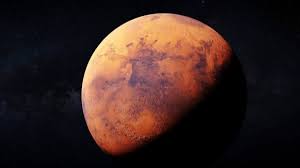Ahmedabad-based Physical Research Laboratory (PRL) has recently unearthed three craters on the surface of Mars, shedding light on the planet’s watery history. Named ‘Lal,’ ‘Mursan,’ and ‘Hilsa,’ these craters offer intriguing insights into Mars’ geological past and potential habitability.
1. Lal Crater: A Tribute to Professor Devendra Lal
1.1 Unveiling Lal Crater
- The largest among the trio, spanning approximately 65 kilometers in diameter, ‘Lal Crater’ pays homage to the late Professor Devendra Lal, a renowned cosmic ray physicist from Varanasi. Professor Lal’s significant contributions to cosmic ray physics and space research have earned him this honor.
1.2 Discoveries Within Lal Crater
- Utilizing SHARAD (Mars SHAllow RADar sounder), researchers identified substantial sedimentary deposits within Lal Crater, suggesting the presence of water bodies in Mars’ ancient history. This finding contributes immensely to our understanding of Mars’ climatic evolution and potential habitability.
2. Mursan and Hilsa Craters: Cultural Significance
2.1 Cultural Homage
- Situated adjacent to Lal Crater, ‘Mursan Crater’ and ‘Hilsa Crater’ derive their names from the towns of Mursan in Uttar Pradesh and Hilsa in Bihar, India, respectively. This naming choice celebrates the rich cultural heritage of these regions, intertwining terrestrial history with celestial exploration.
2.2 Role of SHARAD Technology
- The discovery of these craters was made possible by SHARAD, a cutting-edge subsurface sounding radar mounted on NASA’s Mars Reconnaissance Orbiter (MRO). This technology enables scientists to delve beneath Mars’ surface, unraveling its geological mysteries.
3. Tharsis Volcanic Plateau: Home to Martian Wonders
3.1 Martian Geological Marvels
- The three craters are situated within the Tharsis volcanic region of Mars, a vast plateau housing some of the largest volcanoes in the Solar System. This region, centered near Mars’ equator in the western hemisphere, provides a fertile ground for geological exploration.
3.2 PRL’s Recommendation and IAU Approval
- Following PRL’s recommendation, the International Astronomical Union (IAU) Working Group for Planetary System Nomenclature approved the official names of these craters on June 5. This recognition underscores the significance of these discoveries in planetary science.
The unveiling of Lal, Mursan, and Hilsa Craters marks a significant milestone in our exploration of Mars. These discoveries not only deepen our understanding of the Red Planet’s geological past but also underscore the potential for habitability beyond Earth. As we continue to unravel Mars’ mysteries, each new revelation brings us closer to unlocking the secrets of our neighboring planet.




